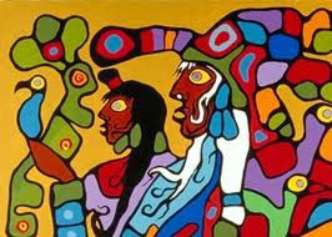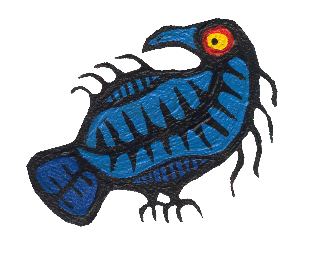Native-Art-in-Canada has affiliate relationships with some businesses and may receive a commission if readers choose to make a purchase.
- Home
- Vision Quest
Vision Quest
So What's Your Life About?

A vision quest is simply an ongoing search for the meaning and purpose of life ... not existential life . . your life.
Ultimately it answers the questions... Who am I? What am I supposed to be doing here? Did I just slip off the rails? Is this working? Am I making a contribution or getting in the way?
Whatever the culture they are born into, folks like to think that there's some sort of significance to their existence, that there's more to life than just survival and eventual oblivion. For the Ojibwa, their understanding of their role in the universe is inextricably linked to creation and the creator himself.
Nowadays, if for some obscure reason the subject of vision quest comes up in conversation, the image that often comes to mind of the naive and gullible is that of a young man struggling up a mountain in the dead of night - with flashes of lightning, and waves of thunder adding a touch of surreal spirituality.
If you're struggling with questions about what the heck you should do with the rest of your life... don't worry about finding a mountain to climb. It's just a metaphor to create the idea that your quest for meaning might end up being an uphill struggle. But, given the morass of confusion that overwhelms even our smallest decisions it's probably an apt image to keep in mind if you're hoping to make sense of the mess you're in.
The Anishnabe Vision Quest
For the Ojibwa the meaning of life was understood through their comprehension of Creation. They knew that from nothing, other than conceiving of the possibility, Kitchi-Manitou had created the universe and everything in it. They also knew that Manitou had given man this same imaginative foresight - an ability to create a future that is not pre-ordained. It was clear to the so-called simple minds of those so-called savage beings that although man had a corporeal existence he also had the capacity to dream - to have a vision of his own position in the universe. A vision of what he might do with the life given him. And with that gift of vision came the moral responsibility for each man to discover his OWN purpose and bring that revelation into existence.
How This Worked in Practice
Although man is born with the capacity to create meaning for himself, it doesn't happen automatically. It's a process of growth - first physically, then spiritually through self-awareness. The successful quest was, and still is, a defining moment in the spiritual development of any man.
Traditionally the Anishnabe life was divided into four units - referred to as hills. The hills corresponded to the four stages of a man's life. It was necessary to climb one hill to get to the next... climbing again suggests effort.
The Hills to Climb Towards a Successful Vision Quest
Infancy - a time when those around you contributed to your life and well being and prepared you for responsibility.
Youth - a time when it was required that you master the skills necessary to take care of your physical self , but also a time to prepare yourself to be mentally and morally worthy of receiving your purpose in life - your vision. Conscious preparation (the quest) was ongoing.
Adulthood - with survival skills mastered and moral sensitivity developed, the gift of vision was possible. Vision came only when a man was ready. Not everyone received the gift of vision but, because it always depended on personal effort, it was always possible to attain if one persevered.
Old age - the fulfillment of vision.
These phases of life corresponded with the stages a man went through in realizing his moral/spiritual responsibilities - preparation, the quest, the vision and the fulfillment.
The Anishnabe have a saying: "No man begins to be until he has seen his vision." It means that a man is just surviving in the world, much like an animal, until he has done the work required to fathom his purpose. Fathom is such a good word to use here. It means to understand, to work out the meaning - but it also implies depth.
So, what I'm saying is, that it takes a lot of effort and deep thought to get a clear vision of your particular purpose in life.
How Your Quest Might Go off the Rails
You may have noticed that it's really difficult to think clearly and come up with workable solutions to your survival problems, let alone have a clue what it all means, when the boss is giving you signals that he thinks you're screwing up, you're worried that your spouse may be having an affair with your best friend and your fifteen year old daughter came home last night with the announcement that she's pregnant, she's in love and she wants to marry the son of a bitch!
You need a break!
You can't think straight!
You've got to get away from it all!
The Ojibwa Solution
For similar reasons, the Ojibwa tradition of a vision quest being part of a ceremonial separation from the community made it possible for individuals to think more clearly about their role in the unfolding of what's possible in their universe.
The Ojibwa vision quest included a solitary period away from social distractions. As boys began the transition into manhood, they were taken to a remote location that was conducive to spiritual awakening. It was a place that allowed for solitary contemplation regarding the relationship between living and being.
To sustain life one needed only to provide the basic necessities of food, water and shelter. But "to be" required an understanding of who you were, why you were here and what you were going to do about that.
Away from the community, focusing on his own abilities and needs, the youth tried to bring his inner being and his physical body into a common accord. He tried to envision a life that would allow him to use his unique abilities in a significant way.
For a few the vision of themselves came early and they moved on to the next stage of fulfillment. For others the vision quest took years. A man would only receive his vision when he was ready. Never before. And for the Anishnabeg a youth was not a real man until he had done the spiritual and emotional work needed to receive the vision of who he was to be in his lifetime. Because supernatural forces were integral to the reception of the vision it was demanded that the individual live his life in fulfillment of his potential in respect of those supernatural forces.
Throughout the Vision Quest The Meaning of Life Unfolds
Three kinds of visions could occur. The first type of vision came during the ceremonial quest if the youth had done the necessary preparation. If he was ready, his vision of himself at that time was always complete and the message was clear.
But not everyone was able to see themselves clearly. Not everyone received a vision at the time of the ceremonial quest.
But as life continued back in the real world and individuals bumped up against the trials and tribulations of their lives they could also receive new insights. That growth allowed for new possibility. A new vision of how it was possible to live one's life.
In that way, although a man was only receptive to minor changes in his life at any given time, if he continued to consciously apply himself, his vision of himself might finally unfold and the meaning of his life become clear.
The third type of vision was similar to the first with the exception that it came during sleep as a dream. It was usually so powerful that it caused the dreamer to wake-up to a conscious new awareness of himself. That type of vision is known as apowawin which means an awakening (to self).
A Vision Quest is Ongoing
Men are only men. They aren't perfect. They don't lead perfect lives. At any moment they may 'forget' their commitments or shy away from the responsibility of their power.
The birch scrolls of the midewiwin show that men and women following the path of life on their way to fulfilling their vision quest, might take up to nine errant trails. Any one of which meant that they had betrayed their vision, their purpose for being in the world.
The moral of the story is to be straight with yourself. Tell it like it REALLY is. Stand up and try again.
...and again.






